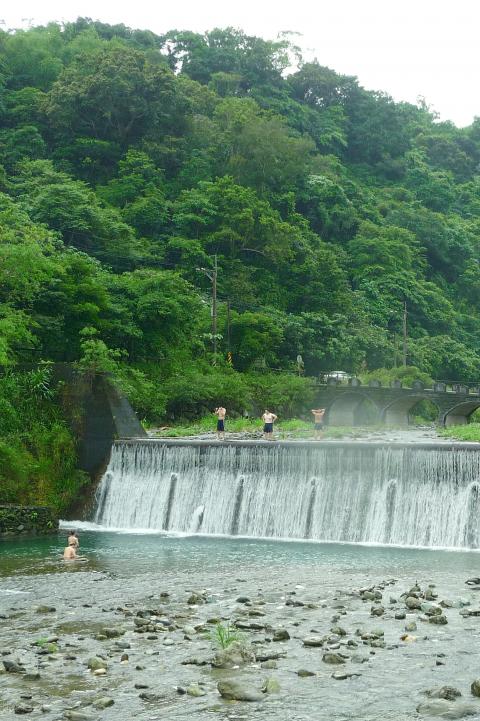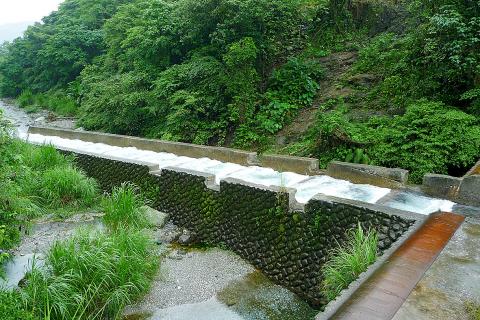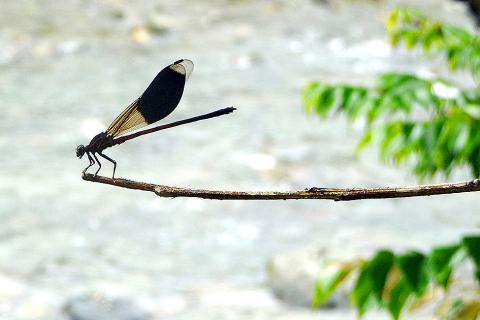Where I come from, people say that if you’re thinking of buying a piece of real estate, you should view it in bad weather. Baibao Creek (白鮑溪) in Hualien County passes that test with ease.
The Chinese-language blogosphere is awash with photos of tourists frolicking in the creek beneath blue skies. However, I’ve been as far up this short valley as it’s possible to ride a motorcycle three times, and on each occasion the weather has been inclement. Despite this, it remains a favorite place of mine, neither crowded nor remote.
While exploring the valley, I’ve never come close to seeing the top of Mukua Mountain (木瓜山). The creek’s source is on the southern slopes of this 2,427-meter-tall mountain.

Photo: Steven Crook
Driving to the creek from Shoufeng Railway Station (壽豐火車站) takes less than 20 minutes, although the bilingual signs aren’t obvious until you get onto Highway 9C (台9丙), the road to Liyu Lake (鯉魚潭). Near the 21.5km marker, a sign will direct you up a side road. There’s a small parking lot at the end of this road, but you’ll likely want to stop once or twice before then to take in the scenery.
Many waterways in western Taiwan are hemmed in by concrete. Baibao Creek — a tributary of the Hualien River — is different. One reason is that the central government’s Forestry Bureau has designated it an outdoor hydrology/ecology classroom. The local climate is another reason: the eastern half of the island has never been as susceptible to flooding as the western lowlands.
In Taiwan’s highlands, many streams are punctuated by weirs built to control sediment washing out of the mountains and into reservoirs. Barriers of this sort make it very difficult for fish to move up and down rivers, and their proliferation is thought to be one of the reasons why the number of Formosan landlocked salmon dwindled after the early 1960s. Of the various eco-engineering techniques which have been applied to Baibao Creek, fish ladders, which allow fish to make their way upstream by leaping and swimming up one shallow step at a time, are the most obvious.

Photo: Steven Crook
Where the creek’s banks have needed stabilizing, the reinforcing materials are stone and lumber. The environment is as pristine as is possible in such an accessible spot; if you’re quiet and observant, you’ll see an impressive range of creatures.
According to ebird.org, a Web site through which birders report what they see, at least 88 avian species have been spotted around the creek. In addition to the usual egrets and crested serpent eagles, the delightfully cute Japanese White-eye and the gloriously colorful Gray-chinned Minivet (much of its body is a rich shade of orange) make frequent appearances.
One of the more unusual amphibian residents is buergeria robustus (褐樹蛙); it doesn’t have an English name because it’s endemic to Taiwan. The Chinese name translates as “brown tree frog.” Among creatures which stay in the water are shrimps, the dark brown candidiopotamon rathbuni crab and the Taiwan shovel-jaw carp (onychostoma barbatulum).

Photo: Steven Crook
JADE INDUSTRY
Baibao Creek is also associated with Taiwan’s jade industry, which flourished millennia ago (some was traded as far away as what’s now Malaysia), and again in the 20th century. Many people know that Taiwan has at times been the world’s top manufacturer of tennis rackets, sewing machines and printed circuit boards. Far fewer are aware that Taiwanese mines produced more than half of the world’s nephrite (one of the two types of jade; the other is jadeite) between 1962 and 1986.
Scouring the creek bed for pieces of nephrite and serpentine is almost as popular a pastime among visitors as splashing in the water. However, I haven’t been able to find out if removing material of this kind is legal or not. If you’re determined to take home this kind of souvenir, visiting one of the local jade workshops is a far better option.

Photo: Steven Crook
Shoufeng Township has two other places that could interest travelers curious about water ecosystems. Fengjhihgu Wetland Park (豐之谷溼地公園) is a few kilometers west of Shoufeng Railway Station. Chinese-speakers may want to sign up for DIY activities like papermaking and handkerchief dyeing. Alternatively, find a quiet spot and watch the ducklings follow their mothers.
Almost next door to Fengjhihgu Wetland Park, Li Chuan Aquafarm (立川漁場) specializes in nurturing a particular type of mollusk. The freshwater Taiwan Clam (corbicula fluminea formosa) is an endemic subspecies of the Asian clam that’s considered a troublesome invasive in parts of the Americas.
The Taiwan Clam was previously so common that a Hoklo-language version of “kill two birds with one stone” is it kiam ji koo, bong la-a kiam se khoo, “gather clams while washing your pants.” In the days of yore, of course, country people did their laundry in the nearest creek.
Nowadays, the Taiwan Clam is seldom found in nature, due to the use of ammonium-based fertilizers and the rebuilding of irrigation ditches with concrete. The almost triangular shell is usually dark brown or even black, but because the water in Shoufeng is so clean, the mollusks cultivated here are yellowish brown and promoted as “golden clams” (黃金蜆). They need seven to eight months to mature. Cold weather can slow their growth — but should never deter humans from visiting this splendid area.
Steven Crook has been writing about travel, culture, and business in Taiwan since 1996. Having recently co-authored A Culinary History of Taipei: Beyond Pork and Ponlai, he is now updating Taiwan: The Bradt Travel Guide.

Exceptions to the rule are sometimes revealing. For a brief few years, there was an emerging ideological split between the Democratic Progressive Party (DPP) and Chinese Nationalist Party (KMT) that appeared to be pushing the DPP in a direction that would be considered more liberal, and the KMT more conservative. In the previous column, “The KMT-DPP’s bureaucrat-led developmental state” (Dec. 11, page 12), we examined how Taiwan’s democratic system developed, and how both the two main parties largely accepted a similar consensus on how Taiwan should be run domestically and did not split along the left-right lines more familiar in

As I finally slid into the warm embrace of the hot, clifftop pool, it was a serene moment of reflection. The sound of the river reflected off the cave walls, the white of our camping lights reflected off the dark, shimmering surface of the water, and I reflected on how fortunate I was to be here. After all, the beautiful walk through narrow canyons that had brought us here had been inaccessible for five years — and will be again soon. The day had started at the Huisun Forest Area (惠蓀林場), at the end of Nantou County Route 80, north and east

This month the government ordered a one-year block of Xiaohongshu (小紅書) or Rednote, a Chinese social media platform with more than 3 million users in Taiwan. The government pointed to widespread fraud activity on the platform, along with cybersecurity failures. Officials said that they had reached out to the company and asked it to change. However, they received no response. The pro-China parties, the Chinese Nationalist Party (KMT) and Taiwan People’s Party (TPP), immediately swung into action, denouncing the ban as an attack on free speech. This “free speech” claim was then echoed by the People’s Republic of China (PRC),

Specialty sandwiches loaded with the contents of an entire charcuterie board, overflowing with sauces, creams and all manner of creative add-ons, is perhaps one of the biggest global food trends of this year. From London to New York, lines form down the block for mortadella, burrata, pistachio and more stuffed between slices of fresh sourdough, rye or focaccia. To try the trend in Taipei, Munchies Mafia is for sure the spot — could this be the best sandwich in town? Carlos from Spain and Sergio from Mexico opened this spot just seven months ago. The two met working in the